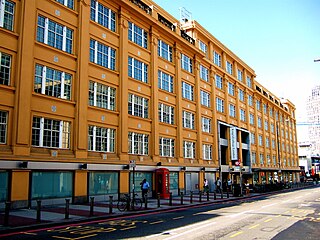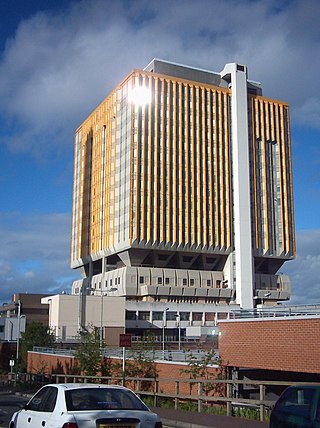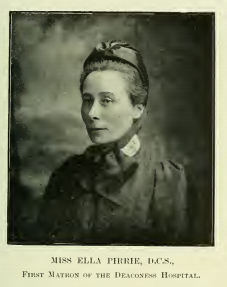
Florence Nightingale was an English social reformer, statistician and the founder of modern nursing. Nightingale came to prominence while serving as a manager and trainer of nurses during the Crimean War, in which she organised care for wounded soldiers at Constantinople. She significantly reduced death rates by improving hygiene and living standards. Nightingale gave nursing a favourable reputation and became an icon of Victorian culture, especially in the persona of "The Lady with the Lamp" making rounds of wounded soldiers at night.

St Thomas' Hospital is a large NHS teaching hospital in Central London, England. It is one of the institutions that compose the King's Health Partners, an academic health science centre. Administratively part of the Guy's and St Thomas' NHS Foundation Trust, together with Guy's Hospital, King's College Hospital, University Hospital Lewisham, and Queen Elizabeth Hospital, it provides the location of the King's College London GKT School of Medical Education.

The Royal London Hospital is a large teaching hospital in Whitechapel in the London Borough of Tower Hamlets. It is part of Barts Health NHS Trust. It provides district general hospital services for the City of London and Tower Hamlets and specialist tertiary care services for patients from across London and elsewhere. The current hospital building has 845 beds, 110 wards and 26 operating theatres, and opened in February 2012.

The Florence Nightingale Faculty of Nursing, Midwifery & Palliative Care is an academic faculty within King's College London. The faculty is the world's first nursing school to be continuously connected to a fully serving hospital and medical school. Established on 9 July 1860 by Florence Nightingale, the founder of modern nursing, it was a model for many similar training schools through the UK, Commonwealth and other countries for the latter half of the 19th century. It is primarily concerned with the education of people to become nurses and midwives. It also carries out nursing research, continuing professional development and postgraduate programmes. The Faculty forms part of the Waterloo campus on the South Bank of the River Thames and is now one of the largest faculties in the university.

The Royal Victoria Hospital commonly known as "the Royal", the "RVH" or "the Royal Belfast", is a hospital in Belfast, Northern Ireland. It is managed by the Belfast Health and Social Care Trust. The hospital has a Regional Virus Centre, which is one of the four laboratories in the United Kingdom on the WHO list of laboratories able to perform PCR for rapid diagnosis of influenza A (H1N1) virus infection in humans.

The Mater Infirmorum Hospital, commonly known as The Mater, is an acute hospital in Belfast, Northern Ireland. It provides services to most of North Belfast and South Antrim, reaching as far as Glengormley, Carrickfergus and Newtownabbey It is managed by the Belfast Health and Social Care Trust.

The Belfast City Hospital in Belfast, Northern Ireland, is a 900-bed modern university teaching hospital providing local acute services and key regional specialities. Its distinctive orange tower block dominates the Belfast skyline being the third tallest storeyed building in Ireland. It has a focus on the development of regional cancer and renal services. It is managed by Belfast Health and Social Care Trust and is the largest general hospital in the United Kingdom. In April 2020, due to the global coronavirus pandemic, the tower block was designated one of the UK's Nightingale Hospitals.

Musgrave Park Hospital is a specialist hospital in Belfast, Northern Ireland. It specialises in orthopaedics, rheumatology, sports medicine and rehabilitation of patients of all ages. These specialties are spread out across a large site in the leafy suburbs of South Belfast. The Hospital is named after the 48 acres (19 ha) of adjacent municipal parkland known as Musgrave Park, first opened to the public in 1920. The hospital is managed by the Belfast Health and Social Care Trust.

Dame Alicia Frances Jane Lloyd Still, DBE, RRC, SRN (1869–1944) was a British nurse, teacher, hospital matron and leader of her profession. She was one of the leaders in the campaign for state registration of nurses. Following the Nurses Registration Act 1919 she was a member of the General Nursing Council (1920-1937). As chairwoman of the General Nursing Council's first Education and Examinations Committee she helped establish the first national examination standards for the registration of nurses.

Reverend William O'Neill, 1st Baron O'Neill was an Anglo-Irish hereditary peer, clergyman and musical composer. Born William Chichester, he changed his surname to O'Neill in 1855.

Sir William Whitla was an Irish physician and politician.

Eva Charlotte Ellis Luckes was Matron of The London Hospital from 1880 to 1919.
Andrew George Malcolm (1818–1856) was an Irish physician and medical historian, who was employed by the General Hospital in Belfast. He has been called the "earliest respiratory physiologist" of the hospital. Today, he is mostly known for his reports on the sanitary state of Belfast and particularly for his History of the General Hospital. Malcolm is also considered to be the "first historian" of Belfast General Hospital.
The history of nursing in the United Kingdom relates to the development of the profession since the 1850s. The history of nursing itself dates back to ancient history, when the sick were cared for in temples and places of worship. In the early Christian era, nursing in the United Kingdom was undertaken by certain women in the Christian Church, their services being extended to patients in their homes. These women had no real training by today's standards, but experience taught them valuable skills, especially in the use of herbs and folk drugs, and some gained fame as the physicians of their era. Remnants of the religious nature of nurses remains in Britain today, especially with the retention of the job title "Sister" for a senior female nurse.

The Queen Street RUC Station was a Royal Ulster Constabulary (RUC) station in Belfast, Northern Ireland, from 1933 to 2000. Before that, it was used as the main premises of the Royal Belfast Hospital for Sick Children from 1878 to 1932. It has been effectively abandoned since 2000 and is visibly deteriorating. The building was granted listed status in 1979.

Miss Isabella "Ella" Barbour Pirrie, DCS (1857–1929), was the first nurse in the Belfast Union Workhouse Infirmary, establishing a nursing school there. She went on to become the first matron at the Deaconess Hospital, Edinburgh, established by Archibald Charteris as a training school for nurses.
Florence Eileen Elliott OBE was a Northern Irish nurse who has been described as "one of the most outstanding nurses that Northern Ireland has produced". She was awarded an OBE in 1951.

The Royal Jubilee Maternity Hospital is a maternity facility in Grosvenor Road, Belfast, Northern Ireland. It is managed by the Belfast Health and Social Care Trust.

James MacDonnell was an Irish physician and polymath who was an active and liberal figure in the civic and political life of Belfast. He was a founding patron of institutions that have since developed as the Royal Victoria Hospital, the Royal Belfast Academical Institution and the Linen Hall Library and, beginning with the organisation of the Belfast Harpers Assembly in 1792, was a promoter of efforts to preserve and revive Irish music and the Irish language. Among some of his contemporaries his reputation suffered in 1803 as a result of his making a subscription for the arrest of his friend, the outlawed United Irishman Thomas Russell.
Jessie Lennox (1830-1933) was a British nurse, trained at Florence Nightingale's school of nursing. She is also known for accompanying the writer Anna Mackenzie and Mary Livingstone, wife of David Livingstone, when they travelled to Africa to find him in 1862.


















